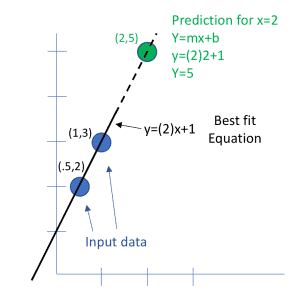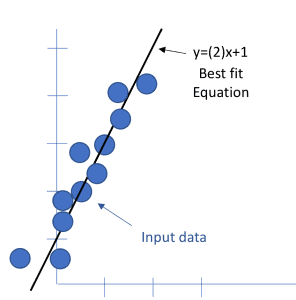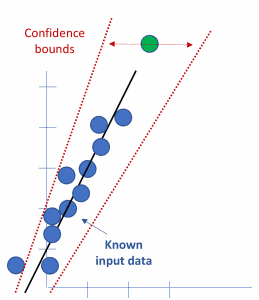
Many of our customers (internal/external) trust us when we say that a Weibull analysis is the best approach to understanding what the data set is telling us. We then take their data set, do something mysterious where no one can see us, and then present these accurate predictions as to what is going to happen with a given population of the product at some future date.
Yes, Weibull analysis in its entirety is complex, but the base principle is pretty simple, and even something we are all familiar with. I believe we can all recall being given two points on a graph and asked to derive the equation for the line that will capture those two points. We did this by finding the factors in the equation for a line.
- The equation is “y=mx+b”
- The line this equation creates crosses the y-axis at “b”
- It has a slope of “m”
- And for any given x coordinate “x”, it will have a y coordinate of “y”
So having derived this equation from these two points you can now “predict” other points along the line. If the “x” axis happened to be representative of time then you could predict where the line would be in the future by entering a larger “x” value.
And that is it! That is the basic principle of what a Weibull distribution is used for with a data set.
So why is Weibull so complex?
1: No one gives you two data points. The last set I received had 47,000 data points
So now you have to estimate what is going to be the “best fit” line to characterize that population.
2: Ok if that is a “best fit” line then what is the range that I can be 90% confident the true line is within?
Now we need to calculate confidence bounds.
3: The data set is most likely not easily characterized as a straight line
So obviously a line is not going to characterize all data sets. We need equations with more variables that can interact in a higher level of complexity to capture more complex behavior. Many exist, but Weibull is used often due to it’s dynamic ability to twist itself into almost any shape.
That’s why we data lovers so often pull our Weibull tools out of the toolbox when we need to find out what the data is trying to tell us and make a prediction.
Adam-




 Ask a question or send along a comment.
Please login to view and use the contact form.
Ask a question or send along a comment.
Please login to view and use the contact form.
I have read few books and multiple articles on Weibull but I must say that this article explained this difficult concept in very simple and graspable manner.
Please keep sharing your knowledge.
Ashish,
Thank you so much for the compliment. I have found that so many texts on statistical and reliability analysis topics do skip that first layer of connection to basic principles. I will continue to share these. My next one is on stress margin testing. I will share one of my favorite examples of this practice done with surgical precision. There is a video demonstrating it and it is really cool.
Take Care,
Adam
My pleasure!!
We want to perform Weibull analysis for a machinery located in a industry but the problem is, we have data for last 3 years and this machine was commissioned 5 year back and in production since then. Therefore, I wish to know is it feasible to perform Weibull analysis without having data of first failure? You may also share any case study related to similar situation.
Ashish, Yes you can perform a Weibull analysis with a partial data set. It simply is a matter of the more estimations and omitted data the lower the confidence in the result. It’s usually a case of finding the crossover between the energy to invest in fact gathering vs the accuracy improvement of the results. Feel free to contact me directly. We can even do a call if you like abahret@aperidge.com
Regards,
Adam
HI Ashish and Adam, with repairable systems a Weibull analysis is likely not the right choice. If the system fails for the same item that is replaced then it is a time to failure analysis of the specific non-repairable item. If the reasons for failure varies or is an adjustment on the equipment, then look at mean cumulative function for the analysis approach. cheers, Fred
Hello Adam and Fred Sir,
Thanks a lot for the valuable suggestions.
I am also exploring this interesting paper shared with me by Mr. Mark Powell-
http://www.attwaterconsulting.com/papers/Powell%202010%20IEEEAC_Paper%201239%20v3%202010-01-05.pdf
Best Regards
Ashish
Simple and to the point explanation for the newcomer. It would be nice if you could augment this by an example.
Thank you for sharing.